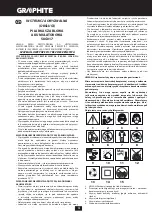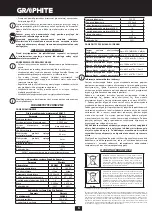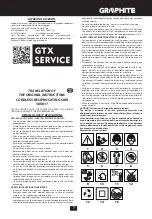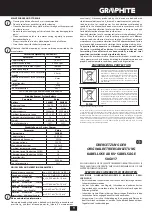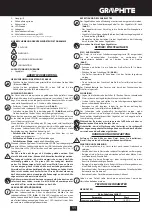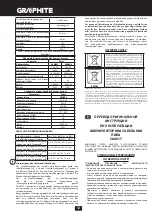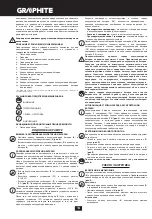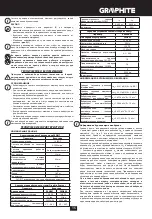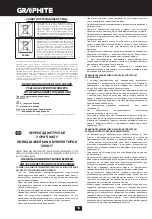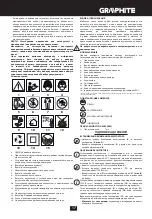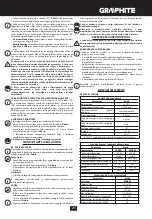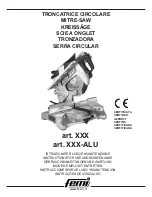
8
1.
CAUTION! Use precaution measures.
2.
Read instruction manual, observe warnings and safety conditions
therein!
3.
Use personal protection equipment (protective goggles, earmuff
protectors).
4.
Use dust mask!
5.
Use protective gloves.
6.
Keep the tool away from children.
7.
Use protective clothes.
8.
Protect the tool from moisture.
9.
Remove the battery from the device before starting any
adjustments or cleaning related tasks.
10.
This device is designed to operate indoors.
11.
Maximum permissible cell temperature 45°C.
12.
Do not throw cells into fire.
13.
Recycling.
14.
Charger protection class 2.
15.
Do not throw cells into water.
CONSTRUCTION AND USE
Reciprocating saw is a battery-powered tool. It is driven with a DC
commutator motor whose rotary movement is transformed to
reciprocating movement. The tool is designed for making straight,
coarse cuts, curved cuts and holes in wood, wood-based materials,
plastics and metals (provided that appropriate blade is used). Range of
use covers repair and building works, and any work from the range of
individual, amateur activities (tinkering).
Use the power tool in accordance with the manufacturer’s
instructions only.
DESCRIPTION OF DRAWING PAGES
Below enumeration refers to the device elements depicted on the
drawing pages of this manual.
1.
Blade
2.
Base
3.
Lever for quick blade installation
4.
Front handle
5.
Switch lock button
6.
Switch
7.
Main handle
8.
Battery lock button
9.
Battery
10.
LED diodes
11.
Charger
12.
Button for battery level indication
13.
Battery level indicator (LED)
* Differences may appear between the product and drawing.
MEANING OF SYMBOLS
CAUTION
WARNING
ASSEMBLY / SETTINGS
INFORMATION
EQUIPMENT AND ACCESSORIES
1.
Blade
- 1 pce
PREPARATION FOR OPERATION
REMOVING AND INSERTING THE BATTERY
•
Push the battery lock button (
8
) and slide out the battery (
9
) (
fig. A
).
•
Insert charged battery (
9
) into the handle holder, you should hear
when the battery lock button (
8
) snaps.
BATTERY CHARGING
The device is supplied with partially charged battery. The battery
should be charged in ambient temperature between 4°C and 40°C. New
battery, or one that has not been used for a long time, will reach full
efficiency after approximately 3 to 5 charge/discharge cycles.
•
Remove the battery (
9
) from the device (
fig. A
).
•
Connect the charger (
11
) to mains socket (230 V AC).
•
Slide the battery (
9
) into the charger (
11
) (
fig. B
). Ensure the battery is
properly fitted (pushed to the end).
When the charger is connected to a mains socket (230 V AC), the green
diode (
10
) on the charger turns on to indicate connected supply.
When the battery (
9
) is placed in the charger (
11
), the red diode (
10
) on
the charger turns on to indicate that the charging is in progress.
At the same time green diodes (
13
) of the battery level indication are
flashing in different configurations, see description below.
• All diodes are flashing
– the battery is empty and requires charging.
• 2 diodes are flashing
– the battery is partially discharged.
• 1 diode is flashing
– the battery level is high.
Once the battery is charged, the diode (
10
) on the charger lights green,
and all battery level diodes (
13
) light continuously. After some time
(approx. 15 s) the battery level indication diodes (
13
) turn off.
Do not charge the battery for more than 8 hours. Exceeding this time
limit may cause damage to battery cells. The charger does not turn
off automatically when the battery is full. Green diode on the charger
will remain on. Battery level indication diodes turn off after some
time. Disconnect power supply before removing the battery from the
charger socket. Avoid consecutive short chargings. Do not charge the
battery after short use of the tool. Significant decrease of the period
between chargings indicates the battery is worn out and should be
replaced.
Batteries heat up when charging. Do not operate just after charging –
wait for the battery to cool down to room temperature. It will prevent
battery damage.
BATTERY LEVEL INDICATION
The battery is equipped with signalisation of the battery level (3 LED
diodes) (
13
). To check battery level status, press the button for battery
level indication (
12
) (
fig. C
). When all diodes are lit, the battery level is
high. When 2 diodes are on, the battery is partially discharged. When
only one diode is lit, the battery is discharged and must be recharged.
BLADE INSTALLATION
Installation and removal of the blade is tool free.
•
Pull the lever for quick blade installation (
3
) upwards (
fig. D
).
•
Slide blade into cut out of the tool holder, push to the limit
•
Lower the lever for quick blade installation (
3
) (the lever will return to
its default position automatically) (
fig. E
).
•
Pull the blade lightly to make sure it is properly fixed.
Use correct blades for the planned task.
OPERATION / SETTINGS
SWITCHING ON / OFF
The device is equipped with the switch lock button (
5
) that protects
against accidental start up. The safety switch is located on both sides
of the tool body (
fig. F
).
Switching on
•
Press one end of the switch lock button (
5
) and hold.
•
Press the switch button (
6
) (
fig. G
).
•
You can release the switch lock button (
5
) after starting the device.
Switching off
•
Release pressure on the switch button (
6
) to stop the tool.
Device speed within its range is controlled with pressure on the switch
button.
CUTTING
•
Place the front part of the base (
2
) flat on the material for processing,
so the blade does not have contact with the material.
•
Start the saw and adjust working speed to properties of processed
material.
•
Move the saw slowly and guide the blade along previously set cutting
line (
fig. H, I
).
Cut at a steady rate, be careful not to overload the saw. Excessive
pressure applied on the blade will suppress operation and will affect
cutting efficiency unfavourably.
During operation whole surface of the base should contact surface of
the processed material.
Make sure that the working tool is installed properly. Improperly or
inaccurately installed working tools can slip during operation and
cause risk for the user.
OPERATION AND MAINTENANCE
Remove the battery from the device before commencing any
activities related to installation, adjustment, repair or maintenance.




